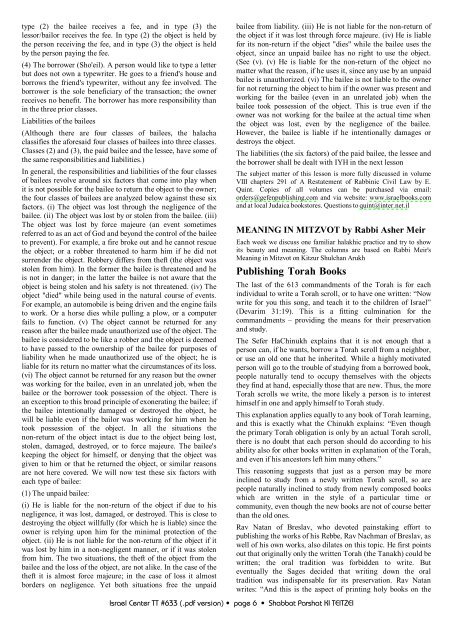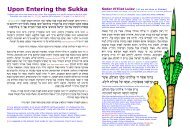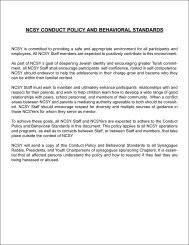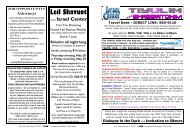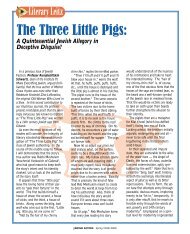You also want an ePaper? Increase the reach of your titles
YUMPU automatically turns print PDFs into web optimized ePapers that Google loves.
type (2) the bailee receives a fee, and in type (3) the<br />
lessor/bailor receives the fee. In type (2) the object is held by<br />
the person receiving the fee, and in type (3) the object is held<br />
by the person paying the fee.<br />
(4) The borrower (Sho'eil). A person would like to type a letter<br />
but does not own a typewriter. He goes to a friend's house and<br />
borrows the friend's typewriter, without any fee involved. The<br />
borrower is the sole beneficiary of the transaction; the owner<br />
receives no benefit. The borrower has more responsibility than<br />
in the three prior classes.<br />
Liabilities of the bailees<br />
(Although there are four classes of bailees, the halacha<br />
classifies the aforesaid four classes of bailees into three classes.<br />
Classes (2) and (3), the paid bailee and the lessee, have some of<br />
the same responsibilities and liabilities.)<br />
In general, the responsibilities and liabilities of the four classes<br />
of bailees revolve around six factors that come into play when<br />
it is not possible for the bailee to return the object to the owner;<br />
the four classes of bailees are analyzed below against these six<br />
factors. (i) The object was lost through the negligence of the<br />
bailee. (ii) The object was lost by or stolen from the bailee. (iii)<br />
The object was lost by force majeure (an event sometimes<br />
referred to as an act of God and beyond the control of the bailee<br />
to prevent). For example, a fire broke out and he cannot rescue<br />
the object; or a robber threatened to harm him if he did not<br />
surrender the object. Robbery differs from theft (the object was<br />
stolen from him). In the former the bailee is threatened and he<br />
is not in danger; in the latter the bailee is not aware that the<br />
object is being stolen and his safety is not threatened. (iv) The<br />
object "died" while being used in the natural course of events.<br />
For example, an automobile is being driven and the engine fails<br />
to work. Or a horse dies while pulling a plow, or a computer<br />
fails to function. (v) The object cannot be returned for any<br />
reason after the bailee made unauthorized use of the object. The<br />
bailee is considered to be like a robber and the object is deemed<br />
to have passed to the ownership of the bailee for purposes of<br />
liability when he made unauthorized use of the object; he is<br />
liable for its return no matter what the circumstances of its loss.<br />
(vi) The object cannot be returned for any reason but the owner<br />
was working for the bailee, even in an unrelated job, when the<br />
bailee or the borrower took possession of the object. There is<br />
an exception to this broad principle of exonerating the bailee; if<br />
the bailee intentionally damaged or destroyed the object, he<br />
will be liable even if the bailor was working for him when he<br />
took possession of the object. In all the situations the<br />
nonreturn of the object intact is due to the object being lost,<br />
stolen, damaged, destroyed, or to force majeure. The bailee's<br />
keeping the object for himself, or denying that the object was<br />
given to him or that he returned the object, or similar reasons<br />
are not here covered. We will now test these six factors with<br />
each type of bailee:<br />
(1) The unpaid bailee:<br />
(i) He is liable for the nonreturn of the object if due to his<br />
negligence, it was lost, damaged, or destroyed. This is close to<br />
destroying the object willfully (for which he is liable) since the<br />
owner is relying upon him for the minimal protection of the<br />
object. (ii) He is not liable for the nonreturn of the object if it<br />
was lost by him in a nonnegligent manner, or if it was stolen<br />
from him. The two situations, the theft of the object from the<br />
bailee and the loss of the object, are not alike. In the case of the<br />
theft it is almost force majeure; in the case of loss it almost<br />
borders on negligence. Yet both situations free the unpaid<br />
bailee from liability. (iii) He is not liable for the nonreturn of<br />
the object if it was lost through force majeure. (iv) He is liable<br />
for its nonreturn if the object "dies" while the bailee uses the<br />
object, since an unpaid bailee has no right to use the object.<br />
(See (v). (v) He is liable for the nonreturn of the object no<br />
matter what the reason, if he uses it, since any use by an unpaid<br />
bailee is unauthorized. (vi) The bailee is not liable to the owner<br />
for not returning the object to him if the owner was present and<br />
working for the bailee (even in an unrelated job) when the<br />
bailee took possession of the object. This is true even if the<br />
owner was not working for the bailee at the actual time when<br />
the object was lost, even by the negligence of the bailee.<br />
However, the bailee is liable if he intentionally damages or<br />
destroys the object.<br />
The liabilities (the six factors) of the paid bailee, the lessee and<br />
the borrower shall be dealt with IYH in the next lesson<br />
The subject matter of this lesson is more fully discussed in volume<br />
VIII chapters 291 of A Restatement of Rabbinic Civil Law by E.<br />
Quint. Copies of all volumes can be purchased via email:<br />
orders@gefenpublishing.com and via website: www.israelbooks.com<br />
and at local Judaica bookstores. Questions to quint@inter.net.il<br />
MEANING IN MITZVOT by Rabbi Asher Meir<br />
Each week we discuss one familiar halakhic practice and try to show<br />
its beauty and meaning. The columns are based on Rabbi Meir's<br />
Meaning in Mitzvot on Kitzur Shulchan Arukh<br />
Publishing Torah Books<br />
The last of the 613 commandments of the Torah is for each<br />
individual to write a Torah scroll, or to have one written: “Now<br />
write for you this song, and teach it to the children of Israel”<br />
(Devarim 31:19). This is a fitting culmination for the<br />
commandments –providing the means for their preservation<br />
and study.<br />
The Sefer HaChinukh explains that it is not enough that a<br />
person can, if he wants, borrow a Torah scroll from a neighbor,<br />
or use an old one that he inherited. While a highly motivated<br />
person will go to the trouble of studying from a borrowed book,<br />
people naturally tend to occupy themselves with the objects<br />
they find at hand, especially those that are new. Thus, the more<br />
Torah scrolls we write, the more likely a person is to interest<br />
himself in one and apply himself to Torah study.<br />
This explanation applies equally to any book of Torah learning,<br />
and this is exactly what the Chinukh explains: “Even though<br />
the primary Torah obligation is only by an actual Torah scroll,<br />
there is no doubt that each person should do according to his<br />
ability also for other books written in explanation of the Torah,<br />
and even if his ancestors left him many others.”<br />
This reasoning suggests that just as a person may be more<br />
inclined to study from a newly written Torah scroll, so are<br />
people naturally inclined to study from newly composed books<br />
which are written in the style of a particular time or<br />
community, even though the new books are not of course better<br />
than the old ones.<br />
Rav Natan of Breslav, who devoted painstaking effort to<br />
publishing the works of his Rebbe, Rav Nachman of Breslav, as<br />
well of his own works, also dilates on this topic. He first points<br />
out that originally only the written Torah (the Tanakh) could be<br />
written; the oral tradition was forbidden to write. But<br />
eventually the Sages decided that writing down the oral<br />
tradition was indispensable for its preservation. Rav Natan<br />
writes: “And this is the aspect of printing holy books on the<br />
Israel Center TT #633 (.pdf version) · page 6 · Shabbat Parshat KI TEITZEI


